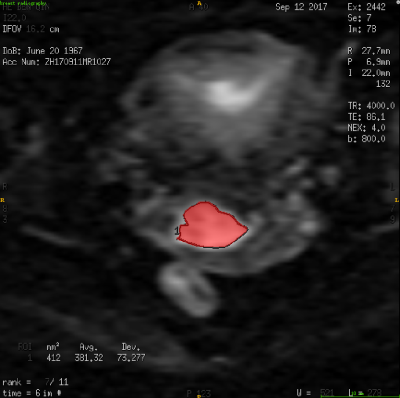Cuiping Li1 and Jiangning Dong2
1Radiology Department, The First Affiliated Hospital of USTC, Division of Life Sciences and Medicine, University of Science, Hefei, China, 2The First Affiliated Hospital of USTC, Division of Life Sciences and Medicine, University of Science and Technology of China, Hefei, China
Synopsis
As the most common
histological type in cervical cancer, cervical
squamous cell carcinoma (CSCC) mainly affects young women, and most of whom are
diagnosed between 35-50 years old. In recent years, studies on tumor biomarkers have continuously
increased, Ki-67 was considered as a kind of nuclear protein related to
cell proliferation, some previous studies have shown that Ki-67 proliferation
index (PI) is positively correlated with
tumor size, invasion, cancer stage and patient survival. In
our study work, we investigated the prediction of Ki-67 PI through combining intravoxel incoherent motion diffusion weighted imaging
(IVIM-DWI) with texture analysis (TA) for CSCC patients.
Abstract
Purpose: This study aims to
determine whether IVIM-DWI combined with texture features based on preoperative
IVIM-DWI could be used to predict the Ki-67 PI, which is a widely used cell
proliferation biomarker in CSCC.
Methods: A total of 70
patients were included. Among these patients, 16 patients were divided into the Ki-67 PI<50% group and 54 patients
were divided into the Ki-67 PI≥50% group based on the retrospective surgical
evaluation. All patients were examined using a 3.0 T MRI unit with one standard
protocol, including an IVIM-DWI sequence with 10 b-values (0-1,500 sec/mm2).
The maximum level of CSCC with a b value of 800 sec/mm2 was selected.
The parameters (diffusion coefficient [D], microvascular volume fraction [f],
and pseudodiffusion coefficient [D*]) were calculated with the ADW 4.6
workstation, and the texture features based on IVIM-DWI were measured using the
GE AK quantitative texture analysis software. The texture features included the
first order, GLCM, GLSZM, GLRLM, and wavelet transform features. The
differences in IVIM-DWI parameters and texture features between the two groups
were compared, and the ROC curve was performed for parameters with group
differences, and in combination.
Results: The D value in the
Ki-67 PI≥50% group was lower than that in the Ki-67 PI<50% group (P<0.05).
A total of 1,050 texture features were obtained using the AK software. Through
univariate logistic regression, mPMR feature selection and multivariate
logistic regression, three texture features were obtained: wavelet_HHL_GLRLM_
LRHGLE, lbp_3D_k_ firstorder_IR, and wavelet_HLH_GLCM_IMC1. The AUC of the prediction model based on the three texture
features was 0.816, and the combined D value and three texture features was
0.834.
Conclusions: Texture
analysis on IVIM-DWI and its parameters were helpful for predicting Ki-67 PI,
and may provide a non-invasive method to investigate important imaging biomarkers
for CSCC.Acknowledgements
We thank all staffs involved in the acquisition of
data. We are grateful to the technical assistance provided by GE Healthcare.References
[1]
Malhone C, Longatto-Filho A. “Cervical, ovarian and endometrial tumor
markers: potential clinical value,” Semin Ultrasound CT MR, vol. 40, no.
4, pp. 350-357, 2019.
[2]
Xu Q, Chen C, Liu B, et al. “Association of iRhom1 and iRhom2 expression
with prognosis in patients with cervical cancer and possible signaling pathways,”
Oncol Rep, vol.
43, no. 1, pp. 41-54, 2020.
[3]
Fan M, Yuan W, Zhao W, et al. “Joint prediction of breast cancer histological
grade and Ki-67 expression level based on DCE-MRI and DWI radiomics,” IEEE J
Biomed Health Inform,vol. 24, no. 6, pp. 1632-1642, 2020.
[4]
O'connor JP B, Rose CJ,
Waterton JC, et al. “Imaging
intratumor heterogeneity: role in therapy response, resistance, and clinical
outcome,” Clin Cancer Res, vol. 21, no.2 , pp. 249-257,2015.
[5]
Yang W, Qiang J W, Tian H P,
et al. “Minimum apparent diffusion coefficient for predicting lymphovascular
invasion in invasive cervical cancer,” J Magn Reson Imaging, vol. 45,
no. 6, pp. 1771-1779, 2017.
[6]
Zheng X, Guo W, Dong J, et al.
“Prediction of early response to concurrent chemoradiotherapy in cervical
cancer: Value of multi-parameter MRI combined with clinical prognostic factors,”
Magn Reson Imaging, vol. 72, pp. 159-166, 2020.
[7]
Gupta N, Bhatele P, Khanna P,
“Glioma detection on brain MRIs using texture and morphological features with
ensemble learning,” Biomedical Signal Processing and Control, vol. 47,
pp. 115-125, 2019.
[8]
SUÁREZ-GARCÍA J G, HERNÁNDEZ-LÓPEZ
J M, MORENO-BARBOSA E, et al. “A simple model for glioma grading based on
texture analysis applied to conventional brain MRI,” PLoS One, vol. 15,
no. 5, p. e0228972, 2020.
[9]
Tagliafico AS, Bignotti B,
Rossi F, et al. “Breast cancer Ki-67 expression prediction by digital breast
tomosynthesis radiomics features ,” Eur Radiol Exp, vol. 3, no. 1, p. 36,
2019.
[10]
Nam KJ, Park H, Ko Es, et al.
“Radiomics signature on 3T dynamic contrast-enhanced magnetic resonance imaging
for estrogen receptor-positive invasive breast cancers: Preliminary results for
correlation with Oncotype DX recurrence scores ,” Medicine, vol. 98, no.
23, p. e15871, 2019.
[11]
Yan FS, Zhou J, Bai Y, et al.
“Clinical and DCE-MRI features of breast cancer in patients with different
Ki-67 status ,” Chin J Med Imaging Technol, vol. 35, no. 11, pp. 1657-1662,
2019.
[12]
Shin Jk, Kim JY, “Dynamic
contrast‐enhanced and diffusion‐weighted MRI of estrogen receptor‐positive
invasive breast cancers: Associations between quantitative MR parameters and
Ki‐67 proliferation status ,” J Magn Reson Imaging , vol. 45, no. 1, pp.
94-102, 2017.
[13]
Surov A, Meyer HJ, Schob S ,
et al. “Parameters of simultaneous 18F-FDG-PET/MRI predict tumor stage and
several histopathological features in uterine cervical cancer ,” Oncotarget,
vol. 8, no. 17, pp. 28285-28296 , 2017.
[14]
Xiao Z, Zhong Y, Tang Z , et
al. “Standard diffusion-weighted, diffusion kurtosis and intravoxel incoherent
motion MR imaging of sinonasal malignancies: correlations with Ki-67
proliferation status,” Eur Radiol, vol. 28, no. 7, pp. 2923-2933, 2018.
[15]
Ng F, Kozarski R, Ganeshan B,
et al. “Assessment of tumor heterogeneity by CT texture analysis: can the
largest cross-sectional area be used as an alternative to whole tumor analysis?,”
Eur J Radiol, vol. 82, no. 2, pp. 342-348, 2013.
